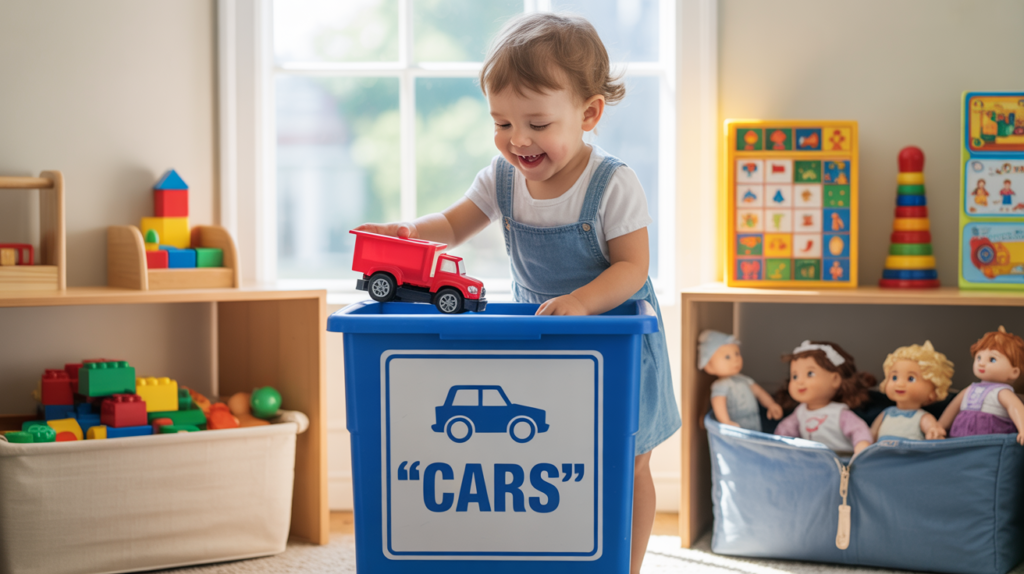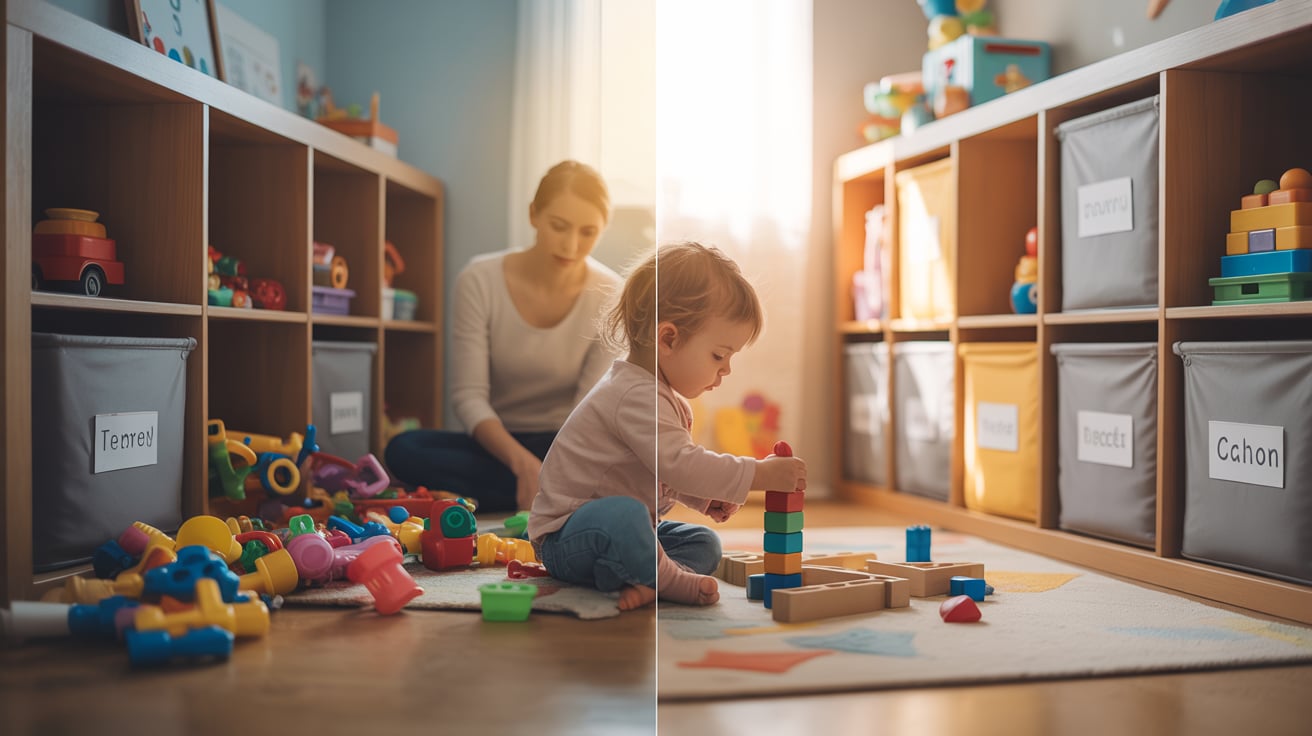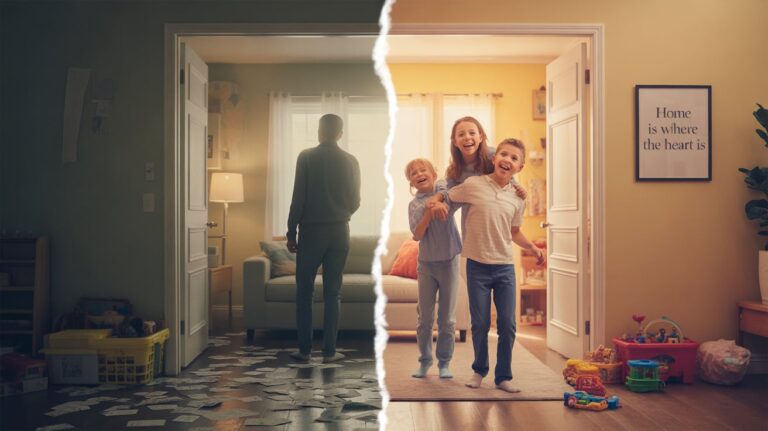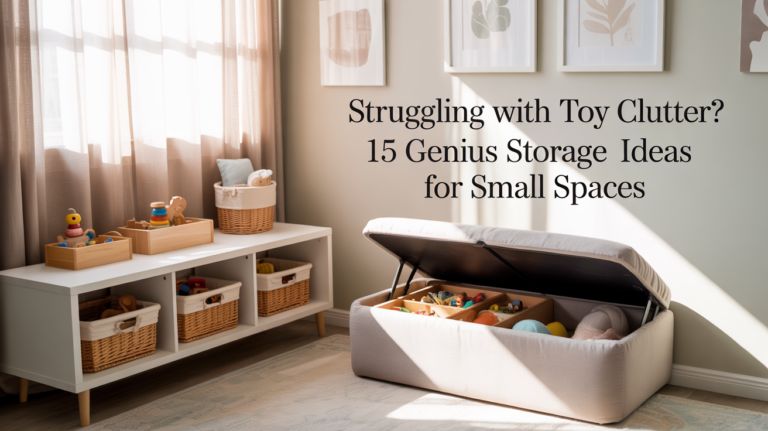How to Organize Toys Effectively for a Clutter-Free and Functional Space
Does your living room resemble a colorful plastic battlefield? If toy clutter is causing parental stress and making your home feel perpetually overwhelmed, you’re not alone. The constant struggle of managing ever-growing collections can turn playtime joy into cleanup dread. B
But imagine a space where peace prevails, where every toy has its place, and children engage in deeper, more focused play. This guide cuts through the chaos, revealing practical, family-friendly strategies on how to organize toys effectively. We’ll show you how to reclaim your sanity and transform your home into a harmonious haven, ensuring you stay hooked on creating lasting order.
Key Takeaways
Looking for a complete home decluttering plan that addresses every corner of your living space? Check out our comprehensive guide on How to Declutter Your Home for strategies that extend far beyond just toys. For broader support in navigating parenthood, explore our Modern Parenting Guide.
What Is Toy Rotation and Why Does It Work So Effectively?
Toy rotation is a simple yet effective strategy for managing toy clutter. Instead of keeping every toy out all the time, you offer a curated selection while storing the rest. Every few weeks, you “rotate” toys—swapping out the current batch with stored ones. It’s the foundation of how to organize toys effectively and encourages deeper play.
This method supports cognitive development by reducing decision fatigue and sensory overload. With fewer options, kids focus longer, use their imagination more, and rediscover stored toys with fresh excitement. It also limits mess, making cleanup routines for kids easier and less stressful.
To start, use labeling storage containers like opaque bins and baskets to organize the toys you’re rotating out. Keep them in closets, under beds, or other hidden spaces. A monthly toy rotation schedule works well, giving kids time to fully engage with what’s available.
Pro tip: Involve your child in the process. Let them pick a few toys to rest and a few to bring back. This builds independence, teaches organization, and makes toy rotation a fun part of family life.
How Do You Categorize Toys for Better Organization?

If your child regularly dumps out entire bins just to find one toy, you’ve likely seen the behavioral impact of clutter firsthand. When toys are stored haphazardly in mixed bins and baskets, it creates cognitive overload—making it harder for kids to focus, play, or clean up. That’s why organizing kids’ toys by category is essential.
Start by grouping toys into logical types: blocks and LEGOs, dolls and action figures, pretend play sets, puzzles and games, art supplies, and vehicles. This method encourages focused play and makes retrieval easier. It also supports minimal toy organization, helping reduce overwhelm while improving cleanup habits.
Use tools that support this system: clear bins for visibility, zippered bags for small pieces, and drawer dividers for art or game parts. Add visual labels with icons or images so even toddlers can recognize what goes where.
Organizing toys this way doesn’t just tame the mess—it encourages independence, extends playtime, and fosters calm. Real parents on platforms like Reddit confirm this method leads to happier, more engaged kids with fewer meltdowns at cleanup time, positively influencing Toddler Behavior and Emotional Growth.
What Type of Toy Storage Actually Works in Real Homes?
Choosing the right toy storage is more than a design choice—it’s about function that fits real family life. Parents often debate open vs closed storage, and both have clear benefits.
Open storage (shelves, baskets) offers easy access and encourages independence during cleanup. However, it can quickly create visual clutter. Closed storage (lidded bins, cabinets, drawers) hides mess and makes use of vertical space but may be harder for younger children to manage.
Most families find a hybrid setup works best: use open storage for daily play and closed storage for rotated or less-used toys.
Popular parent-approved options include:
- Cube storage for toys like IKEA’s KALLAX with labeled drawers or baskets—great for categorizing and concealing.
- IKEA-style shelving + bins for vertical storage that scales as toy collections grow.
- Stackable bins with lids, perfect for closets or garages to store rotated sets.
- Toy ottomans and hidden-storage furniture, ideal for living room toy storage in small spaces.
- Baskets that slide under beds or shelves for flexible, narrow-space storage.
For the best toy organizers for toddlers, prioritize low, sturdy, and accessible designs that support independent play and cleanup.
How to Organize a Messy Playroom (or Create a Play Zone Anywhere)
Even if you don’t have a dedicated playroom, effective playroom organization is entirely achievable. The key is to define purposeful “zones” within your existing spaces, whether it’s a corner of a bedroom, a segment of the living room, or a clearly delineated area in a shared family room. Designating these areas allows for a structured approach to organizing toys.
Define Functional Zones
- Pretend Play Zone: Area for dress-up clothes, play kitchen, or dollhouses.
- Building Zone: Rug or mat with bins for blocks, LEGOs, or construction toys.
- Reading Nook: Cozy corner with small shelf for books and quiet toys.
- Art Station: Child-sized desk with art supplies in caddies or bins.
Actionable Steps for Play Zones
- Use Low Shelves & Baskets: Helps kids access and return toys independently.
- Define with Visual Cues: Use rugs/mats to define areas in shared spaces.
- The Golden Rule: Only keep what fits in the zone—rotate or declutter the rest.
Categorizing toys by type and storing them in designated zones reduces clutter and supports focused play. Kids can easily find and return items, making cleanup simpler. This method keeps even small or multi-purpose rooms tidy and functional, maximizing toy storage ideas for small spaces. Always ensure your play zones are safe and secure; learn more about Home Safety and Proofing for Families.
How Can You Limit Toy Access Without Seeming Harsh?
The dreaded “toy dumping” — where children pull out every single item from every container — is a common frustration and a primary contributor to parental stress from mess. This behavior isn’t typically malicious; it’s often a manifestation of feeling overwhelmed by too many choices.
Limiting toy access can dramatically reduce this chaos and cultivate a deeper appreciation for the toys children do have. This provides effective toy dumping solutions.
Introduce a clear, consistent rule like the “one-bin-out” or “two-bin-out” principle, adjusted for your child’s age and tolerance for choice. This means only one (or a few) designated bins and baskets of toys are accessible at a time. The remaining sets are stored out of sight, perhaps in a closet, a garage, or even child-locked storage if necessary.
Actionable Steps for Limiting Access:
- Give Controlled Choice: “Would you like to play with the blocks bin or the animal figures bin today?” This empowers them, gives them a sense of control over their play environment, and makes them far more likely to respect the established system.
- Involve Kids in Choosing: Let them help pick which bin goes out for the week.
Limiting toy choices helps kids avoid dumping everything out and encourages more focused, imaginative play. Many parents use “toy closets” or chest-style organizers to store rotation toys, only bringing them out at set times—an effective solution to toy dumping. This approach also positively impacts Toddler Behavior and Emotional Growth by reducing frustration.
How Do You Get Kids Involved in Cleaning Up?
Getting kids involved in cleanup isn’t just about a tidy home—it teaches responsibility and independence. Start as early as 18–24 months with simple tasks like putting a block in a bin or a book on a shelf. When children help tidy their toys, they learn the value of order and feel proud of their space. Watching toddlers clean up with confidence is a rewarding milestone for parents.
Actionable Steps to Involve Kids in Cleanup:
- Make Cleanup Fun:
- Use timers: “Let’s see if we can put away all the cars before the timer buzzes!”
- Play music: Designate a specific “cleanup song” that signals the start of tidying time, making it a predictable and even exciting transition.
- Turn it into a game: “Can you find all the red toys?” or “Let’s race the clock!”
- Offer small, meaningful rewards: A sticker on a chart, an extra story at bedtime, or a few minutes of undivided playtime with you can provide positive reinforcement.
Integrate end-of-day routines, such as a quick tidy-up before dinner, bath time, or bedtime. Consistency is paramount. Children thrive on predictability, and knowing when cleanup will happen makes it a natural part of their day, significantly reducing resistance.
Visual cues are incredibly effective for young learners:
- Labels: As discussed, pictures or icons on bins and baskets clearly show where items belong, empowering children to independently put things away.
- Picture charts: A simple chart with photos of toys and their corresponding storage spots can serve as a visual checklist, guiding even non-readers through the cleanup process.
By consistently applying these strategies, you’re not just decluttering toys with kids; you’re actively building essential life skills and transforming cleanup routines for kids into manageable, even enjoyable, moments of shared responsibility.
This directly addresses the behavioral impact of clutter by instilling positive habits early on and contributing to a child’s overall Emotional Growth. These lessons also lay foundational groundwork for How to Raise a Financially Responsible Child.
Is Less Really More When It Comes to Toys? (The Montessori Method)
The pervasive notion that “more toys equal more fun” is increasingly challenged by child development experts and educators. The Montessori method, for example, strongly advocates for fewer, high-quality, open-ended toys that encourage deep, sustained, and imaginative engagement, rather than superficial or fleeting interest. This is a core tenet of minimal toy organization.
There are profound cognitive development benefits associated with a reduced number of toy options. When children have fewer toys available, they are more likely to:
- Engage in deeper, more sustained, and focused play.
- Utilize their imagination and creativity to explore new possibilities with existing toys.
- Develop problem-solving skills by working creatively with limited resources.
- Experience less overwhelm, frustration, and the behavioral impact of clutter.
This approach requires decluttering toys that are over-stimulating, broken, or simply unused. The focus shifts to keeping only the favorites — the high-quality, versatile items that genuinely engage your child — and effectively rotating the rest. Many parents who adopt this philosophy observe that kids play better, longer, and more creatively with less.
This leads to more meaningful playtime, a calmer home environment, and aligns perfectly with a purposeful Montessori toy setup. It’s a powerful antidote to parental stress from mess, and contributes to healthy Holistic Infant Development as well.
Should You Get Rid of Toys That Don’t Fit in Your System?
Once you’ve diligently set up your comprehensive how to organize toys effectively system, you’ll inevitably encounter items that simply don’t fit the new framework. This is a crucial moment for decisive action. To determine whether a toy should stay or go, ask yourself these direct questions:
Is it used?
Be brutally honest. If a toy hasn’t been touched in months—even during rotation—it’s likely not serving a purpose. Let it go.
Is it broken or incomplete?
Missing parts, broken pieces, or irreparable toys should be the first to leave. Don’t let them steal storage space.
Does it fit in a bin?
Oversized or awkward toys that don’t have a proper “home” can ruin your system. If it can’t be stored easily, reconsider its value.
Is it age-appropriate?
Toys that are too young or too advanced for your child often go untouched. Choose toys that truly engage them at their current stage.
It’s time to part ways with the oversized, unmanageable “junk” and prioritize cohesive, manageable sets. A highly effective strategy is to implement the “One In, One Out” rule for birthdays or holidays: for every new toy that enters your home, an existing one must leave. This proactive measure prevents the relentless accumulation that can sabotage even the most meticulously planned systems.
Actionable Steps for Decluttering:
- Sort and Declutter First: Before you organize, sort through all toys. This first step of “decluttering items that are broken, no longer played with, or are missing pieces” is critical.
- Consider Donation or Recycling:
- Donate: Gently used toys can go to charity or be passed on to friends or family members.
- Recycle: Toys not fit for selling or donating should find a new purpose in a toy recycling program if available in your area.
- The “Unsure” Bin: For items you’re truly unsure about, designate an “out of sight” zone (e.g., a clearly labeled bin in a garage, attic, or rarely used closet) for a few months. If no one misses them during that time, it becomes much easier to part ways.
This systematic approach simplifies decluttering toys and ensures that your best toy organizers are only holding items that are truly valued and used. Don’t waste valuable toy storage ideas for small spaces on items that are simply taking up room. For a deeper dive into decluttering your entire living space, see our guide on How to Declutter Your Home.
Sample Weekly Toy Rotation Plan
Here’s a flexible sample weekly toy rotation schedule to help you begin, easily customizable based on your child’s age group (toddlers vs. school-age) and evolving interests. This plan ensures fresh engagement and minimizes clutter, contributing to overall playroom organization.
Preparation Steps for Your Toy Rotation
Set A: Large building blocks, a few cars, a simple animal farm set.
Set B: Chunky puzzles, playdough with tools, a collection of small action figures.
Set C: Duplos, a small doctor’s kit, musical instruments.
Set D: Board games, craft supplies, a sensory bin setup.
Available Toys: Only Set A is accessible (e.g., large building blocks, cars, animal farm set).
Focus: Encourage deep, sustained engagement with these specific items.
Cleanup: Implement daily cleanup routines for kids, guiding them to return Set A toys to their labeled bins and baskets.
Week 2 (Rotation to Set B):
End of Week 1: Involve your child in the “farewell” process, helping to put all of Set A’s toys back into their labeled storage bin.
Beginning of Week 2: Bring out Set B (e.g., puzzles, playdough, action figures). Observe their excitement as these toys feel “new” again.
Week 3 (Rotation to Set C):
Repeat the process: Put Set B away, bring out Set C.
Week 4 (Rotation to Set D):
Repeat the process: Put Set C away, bring out Set D.
Week 5: Bring Set A back out, completing the cycle and starting fresh.
This structured toy rotation schedule keeps playtime dynamic, prevents overwhelm (addressing the behavioral impact of clutter), and makes cleanup a significantly more manageable task for the entire family. It’s a powerful component of how to organize toys effectively.
Conclusion
Mastering how to organize toys effectively isn’t about perfection—it’s about creating a calm, functional space for your child’s growth and your peace of mind. Use strategies like toy rotation, organizing toys by category, and smart toy storage ideas for small spaces.
Balance open vs closed storage, and build simple cleanup routines for kids. Focus on progress over perfection and adjust as your family grows—organization is a journey, not a destination.
Share your toy clutter story or favorite organization tips in the comments below! We’d love to hear what truly works for your family in achieving effective toy organization.



